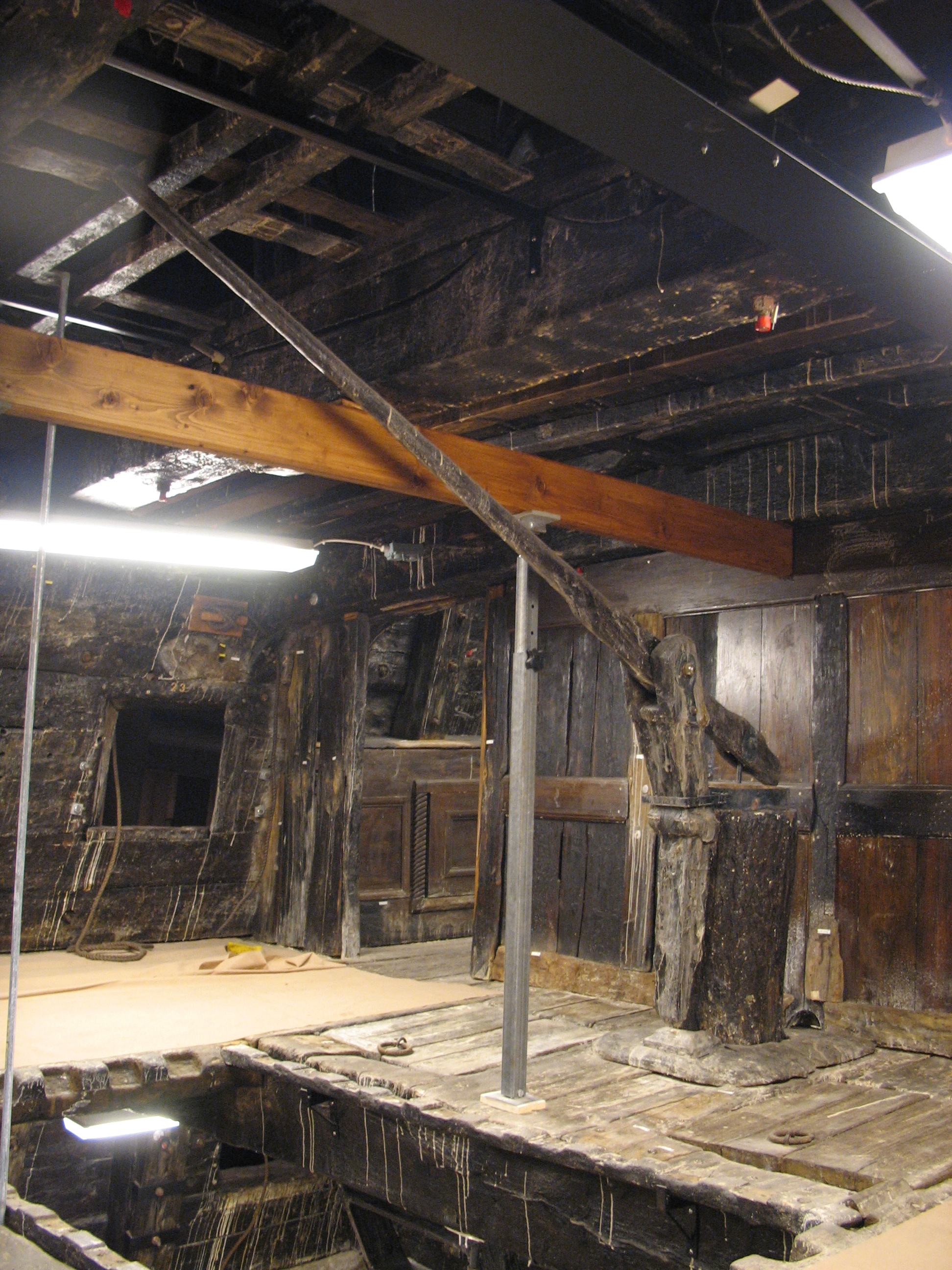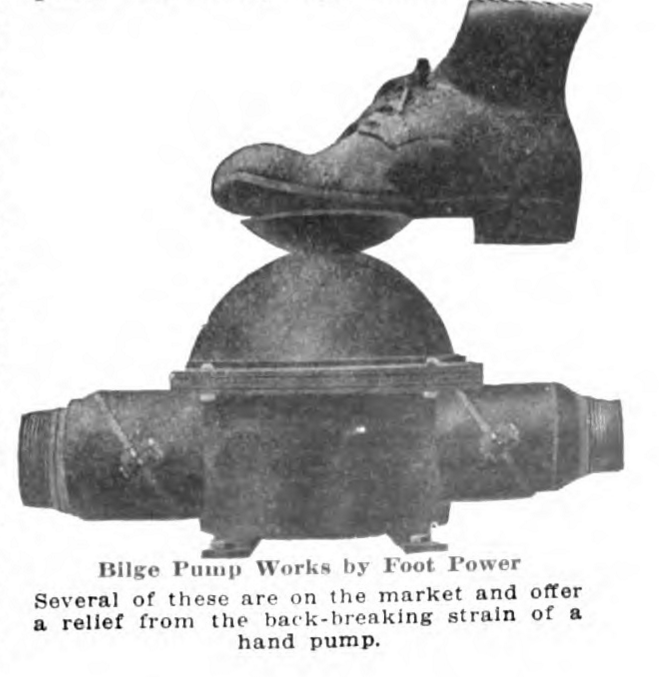Bilge Pump on:
[Wikipedia]
[Google]
[Amazon]
 A bilge pump is a
A bilge pump is a  Force pumps could be made of either wood or bronze. Based on ancient texts, it seems that bronze was the preferred material since it lasted longer and was more easily transported. Wood was easier to build, put together, and repair but was not as durable as bronze. Because these were high-value objects, few are found in shipwrecks; they were often recovered after the ship sank. Force pumps were fairly simple in their construction consisting of a cylinder, a piston, and a few valves. Water would fill the cylinder after which the piston would descend into the cylinder, causing the water to move to a higher placed pipe. The valve would close, locking the water into the higher pipe, and then propelling it in a jet stream.
Force pumps could be made of either wood or bronze. Based on ancient texts, it seems that bronze was the preferred material since it lasted longer and was more easily transported. Wood was easier to build, put together, and repair but was not as durable as bronze. Because these were high-value objects, few are found in shipwrecks; they were often recovered after the ship sank. Force pumps were fairly simple in their construction consisting of a cylinder, a piston, and a few valves. Water would fill the cylinder after which the piston would descend into the cylinder, causing the water to move to a higher placed pipe. The valve would close, locking the water into the higher pipe, and then propelling it in a jet stream.
 A bilge pump is a
A bilge pump is a water pump
A pump is a device that moves fluids (liquids or gases), or sometimes slurries, by mechanical action, typically converted from electrical energy into hydraulic energy. Pumps can be classified into three major groups according to the method they ...
used to remove bilge water. Since fuel can be present in the bilge, electric bilge pumps are designed to not cause sparks. Electric bilge pumps are often fitted with float switch A float switch is a type of level sensor, a device used to detect the level of liquid within a tank. The switch may be used to control a pump, as an indicator, an alarm, or to control other devices.
One type of float switch uses a mercury switch i ...
es which turn on the pump when the bilge fills to a set level. Since bilge pumps can fail, use of a backup pump is often advised. The primary pump is normally located at the lowest point of the bilge, while the secondary pump would be located somewhat higher. This ensures that the secondary pump activates only when the primary pump is overwhelmed or fails, and keeps the secondary pump free of the debris in the bilge that tends to clog the primary pump.
Ancient bilge force pump
A piston pump is a type of positive displacement pump where the high-pressure seal reciprocates with the piston. Piston pumps can be used to move liquids or compress gases. They can operate over a wide range of pressures. High pressure operation ...
s had a number of common uses. Depending on where the pump was located in the hull of the ship, it could be used to suck in sea water into a live fish tank to preserve fish until the ship was docked and the fish ready to be sold. Another use of the force pump was to combat fires. Water would again be sucked in through the bottom of the hull, and then pumped onto the blaze. Yet another suggested use for a force pump was to dispel water from a ship. The pump would be placed near the bottom of the hull so as to suck water out of the ship. Force pumps were used on land as well. They could be used to bring water up from a well or to fill high placed tanks so that water could be pressure pumped from these tanks. These tanks were for household use and/or small-scale irrigation. The force pump was portable and could therefore, as on ships, be used to fight fire.
 Force pumps could be made of either wood or bronze. Based on ancient texts, it seems that bronze was the preferred material since it lasted longer and was more easily transported. Wood was easier to build, put together, and repair but was not as durable as bronze. Because these were high-value objects, few are found in shipwrecks; they were often recovered after the ship sank. Force pumps were fairly simple in their construction consisting of a cylinder, a piston, and a few valves. Water would fill the cylinder after which the piston would descend into the cylinder, causing the water to move to a higher placed pipe. The valve would close, locking the water into the higher pipe, and then propelling it in a jet stream.
Force pumps could be made of either wood or bronze. Based on ancient texts, it seems that bronze was the preferred material since it lasted longer and was more easily transported. Wood was easier to build, put together, and repair but was not as durable as bronze. Because these were high-value objects, few are found in shipwrecks; they were often recovered after the ship sank. Force pumps were fairly simple in their construction consisting of a cylinder, a piston, and a few valves. Water would fill the cylinder after which the piston would descend into the cylinder, causing the water to move to a higher placed pipe. The valve would close, locking the water into the higher pipe, and then propelling it in a jet stream.
Archimedes' screw
The Greek writerAthenaeus of Naucratis
Athenaeus of Naucratis (; grc, Ἀθήναιος ὁ Nαυκρατίτης or Nαυκράτιος, ''Athēnaios Naukratitēs'' or ''Naukratios''; la, Athenaeus Naucratita) was a Greek rhetorician and grammarian, flourishing about the end of t ...
described how King Hieron II commissioned Archimedes to design a huge ship, ''Syracusia
''Syracusia'' ( el, Συρακουσία, ''syrakousía'', literally "of Syracuse") was an ancient Greek ship sometimes claimed to be the largest transport ship of antiquity. She was reportedly too big for any port in Sicily, and thus only saile ...
'', which could be used for luxury travel, carrying supplies, and as a naval warship. ''Syracusia'' is said to have been the largest ship built in classical antiquity. According to Athenaeus, she was capable of carrying 600 people and included garden decorations, a gymnasium and a temple dedicated to the goddess Aphrodite
Aphrodite ( ; grc-gre, Ἀφροδίτη, Aphrodítē; , , ) is an ancient Greek goddess associated with love, lust, beauty, pleasure, passion, and procreation. She was syncretized with the Roman goddess . Aphrodite's major symbols include ...
among her facilities. Since a ship of this size would leak a considerable amount of water through the hull, the Archimedes' screw
The Archimedes screw, also known as the Archimedean screw, hydrodynamic screw, water screw or Egyptian screw, is one of the earliest hydraulic machines. Using Archimedes screws as water pumps (Archimedes screw pump (ASP) or screw pump) dates bac ...
was purportedly developed in order to remove the bilge water. Archimedes' machine was a device with a revolving screw-shaped blade inside a cylinder. It was turned by hand, and could also be used to transfer water from a body of water into irrigation canals. The Archimedes' screw is still in use today for pumping liquids and granulated solids such as coal and grain. The Archimedes' screw described in Roman times by Vitruvius
Vitruvius (; c. 80–70 BC – after c. 15 BC) was a Roman architect and engineer during the 1st century BC, known for his multi-volume work entitled ''De architectura''. He originated the idea that all buildings should have three attribute ...
may have been an improvement on a screw pump that was used to irrigate the Hanging Gardens of Babylon
The Hanging Gardens of Babylon were one of the Seven Wonders of the Ancient World listed by Hellenic culture. They were described as a remarkable feat of engineering with an ascending series of tiered gardens containing a wide variety of tre ...
, but this is disputed due to a lack of actual evidence.
References
{{Authority control Pumps